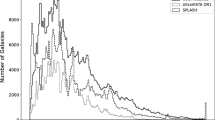Abstract
A method for detecting voids in the galaxy distribution is presented. Using this method, we have identified 732 voids with a radius of the seed sphere R seed > 4.0h −1 Mpc in a volume-limited sample of galaxies from the southern part of the 2dFGRS survey. 110 voids with R seed > 9.0h −1 Mpc have a positive significance. The mean volume of such voids is ∼19 × 103 h −3 Mpc3. Voids with R seed > 9.0h −1 Mpc occupy 55% of the sample volume. We construct a dependence of the volumes of all the identified voids on their ranks and determine parameters of the galaxy distribution. The dependence of the volume of voids on their rank is consistent with a fractal model (Zipf’s power law) of the galaxy distribution with a fractal dimension D ≈ 2.1 (given the uncertainty in determining the dimension using our method and the results of a correlation analysis) up to scales of ∼25h −1 Mpc with the subsequent transition to homogeneity. The directions of the greatest elongations of voids and their ellipticities (oblateness) are determined from the parameters of equivalent ellipsoids. The directions of the greatest void elongations have an enhanced concentration to the directions perpendicular to the line of sight.
Similar content being viewed by others
References
J. Aikio and P. Mahonen, Astrophys. J. 497, 534 (1998).
Y. Barishev and P. Teerikorpi, astro-ph/0505185 (2005).
A. Berlind and D. H. Weinberg, Astrophys. J. 575, 587 (2002).
P. H. Coleman and L. Pietronero, Phys. Rep. 213, 311 (1992).
M. Colles, G. Dalton, S. Maddox, et al. (The 2dFGRS Team), Mon. Not. R. Astron. Soc. 328, 1039 (2001).
M. Colles, B. Peterson, C. Jackson, et al. (The 2dFGRS Team) astro-ph/0306581 (2003).
D. J. Croton, M. Colles, E. Gaztanaga, et al., Mon. Not. R. Astron. Soc. 352, 828 (2004); astro-ph/0401406 (2004).
J. Einasto, M. Joeveer, and E. Saar, Mon. Not. R. Astron. Soc. 193, 353 (1980).
H. El-Ad and T. Piran, Astrophys. J. 491, 421 (1997).
J. Gaite, astro-ph/0510328 (2005).
J. Gaite, private communication (2006).
J. Gaite and S. C. Manrubia, Mon. Not. R. Astron. Soc. 335, 977 (2002); astro-ph/0205188 (2002).
S. Gottlober, E. L. Locas, A. Klypin, and Y. Hoffman, astro-ph/0305393 (2003).
D. W. Hogg, astro-ph/9905116 (1999).
F. Hoyle and M. S. Vogeley, Astrophys. J. 566, 641 (2002); astro-ph/0109357.
F. Hoyle and M. S. Vogeley, Astrophys. J. 607, 751 (2004); astro-ph/0312533.
R. P. Kirshner, A. Jr. Oemler, P. L. Schechter, and S. A. Shectman, Astrophys. J. 248, L57 (1981).
P. Norberg, S. Cole, C. M. Baugh, et al., Mon. Not. R. Astron. Soc. 336, 907 (2002); astro-ph/0111011 (2001).
G. Paladin and A. Vulpiani, Phys. Rep. 156, 147 (1987).
S. G. Patiri, J. Betancort-Rijo, F. Prada, et al., submitted to Mon. Not. R. Astron. Soc.; astro-ph/0506668 (2005).
P. J. E. Peebles, Astrophys. J. 557, 495 (2001).
M. Plionis and S. Basilakos, Mon. Not. R. Astron. Soc. 330, 399 (2002).
H. J. Rood, Ann. Rev. Astron. Astrophys. 26, 245 (1988).
B. S. Ryden and A. L. Melott, Astrophys. J. 470, 160 (1996); astro-ph/9510108.
A. V. Tikhonov, Pis’ma Astron. Zh. 31, 883 (2005) [Astron. Lett. 31, 787 (2005)].
A. V. Tikhonov, D. I. Makarov, and A. I. Kopylov, Bull. Spec. Aastrofiz. Obs., Russ. Akad. Sci. 50, 39 (2000); astro-ph/0106276 (2001).
S. Shandarin, H. A. Feldman, K. Heitmann, and S. Habib, Mon. Not. R. Astron. Soc. 367, 1629 (2006).
G. K. Zipf, Human Behavior and the Principle of Least Effort (Addison-Wesley, Massachusetts, 1949).
Author information
Authors and Affiliations
Additional information
Original Russian Text © A.V. Tikhonov, 2006, published in Pis’ma v Astronomicheskiĭ Zhurnal, 2006, Vol. 32, No. 11, pp. 809–816.
Rights and permissions
About this article
Cite this article
Tikhonov, A.V. Properties of voids in the 2dFGRS galaxy survey. Astron. Lett. 32, 727–733 (2006). https://doi.org/10.1134/S1063773706110028
Received:
Issue Date:
DOI: https://doi.org/10.1134/S1063773706110028




